Portal:New Zealand/Selected article
Selected articles
Selected article 1
Portal:New Zealand/Selected article/1
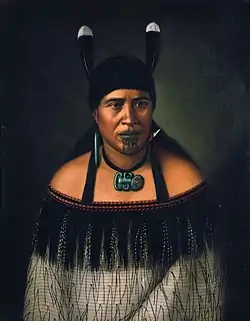
The name "hei-tiki" suggests a connection with Tiki, the first man in Māori legend. Hei-tiki may signify memorials to ancestors, or represent the goddess of childbirth, Hineteiwaiwa. The rationale behind the first idea is that they were often buried when their kaitiaki (guardian) died and would be later retrieved and placed somewhere special to be brought out in times of tangihanga (mourning and associated activities). Because of the connection with Hineteiwaiwa, hei-tiki were often given to a woman by her husband's family if she was having trouble conceiving.
The most valuable hei-tiki are carved from New Zealand greenstone, also called pounamu. Pounamu consists of either nephrite or bowenite (Māori: tangiwai). Pounamu is esteemed highly by Māori for its beauty, toughness and great hardness; it is used not only for ornaments such as hei-tiki and ear pendants, but also for carving tools, adzes, and weapons. (Full article...)
Selected article 2
Portal:New Zealand/Selected article/2

In his Royal Navy career, he served in the Napoleonic wars and was involved in the suppression of piracy in the Caribbean. In 1836 he sailed HMS Rattlesnake to Australia where he spent several months surveying Port Phillip District (later Melbourne).
In 1837 he sailed to the Bay of Islands, New Zealand, in response to a request for help from James Busby, the British Resident, who felt threatened by wars between Māori tribes. He arrived on 26 May 1837 and helped to reduce the tensions. At the time, the British government recognised the sovereignty of the Māori people, as represented in the Declaration of the Independence of New Zealand of October 1835, which had been organised by Busby. Hobson returned to England and was appointed Lieutenant Governor and British consul to New Zealand (confirmed on 13 August 1839). He was instructed to purchase land "by fair and equal contracts."
Hobson arrived back in the Bay of Islands on 29 January 1840 (which is celebrated today as Auckland Anniversary Day) with a small group of officials and almost immediately drafted the Treaty of Waitangi, together with his secretary James Freeman and Busby. After obtaining signatures at the Bay of Islands, he travelled to Waitemata Harbour to obtain more signatures and survey a suitable location for a new capital. In November 1840 the Queen signed a royal charter for New Zealand to become a Crown colony separate from New South Wales. Hobson was sworn in as Governor and Commander in Chief on 3 May 1841. (Full article...)
Selected article 3
Portal:New Zealand/Selected article/3

It offers a wide range of programmes including Arts, Business, Education, Music, Teacher Training and Special Education, Architecture, Planning, Nursing, Creative and Performing Arts, Theology, Science, Information Management, Engineering, Medicine, Optometry, Food and Wine Science, Property, Law, Fine and Visual Arts and Pharmacy.
It also provides the most conjoint combinations across the entire nation, with over 35 combinations available. Conjoint programs allow students to achieve multiple degrees in a shortened period of time.
The University of Auckland was the only New Zealand institution ranked in the top 50 of the THES - QS World University Rankings, ranked at number 46. (Full article...)
Selected article 4
Portal:New Zealand/Selected article/4
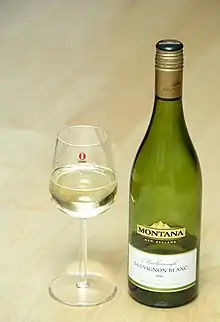
The first vines are thought to have been introduced by missionary Samuel Marsden, and official British Resident James Busby is credited with producing wine at Kerikeri in 1833. The modern wine industry in New Zealand began in the mid-20th century and expanded rapidly in the early 21st century, averaging 17% per annum in the first two decades. In 2017, New Zealand produced 285 million litres from 37,129 hectares (91,750 acres) of vineyard area, about three-quarters of which is dedicated to Sauvignon Blanc. Nearly 90% of total production is exported, chiefly to the United States, Britain and Australia, reaching a record NZ$1.66 billion in export revenue in 2017. In each of the previous 10 years, New Zealanders consumed a fairly constant 20 litres of wine per adult, about a third of which was imported from other countries, mainly Australia. (Full article...)
Selected article 5
Portal:New Zealand/Selected article/5
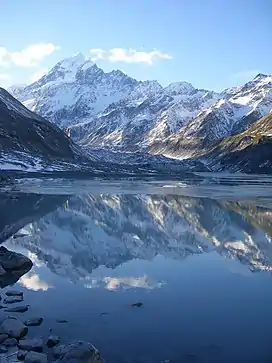
Aoraki means "Cloud Piercer" in the Ngāi Tahu dialect of the Māori language. Historically, the Māori name has been spelt Aorangi in the "canonical" Māori form. While the mountain was known to Māori centuries before, the first European known to see Aoraki/Mount Cook was Abel Tasman, on December 13, 1642 during his first Pacific voyage. The English name of Mount Cook was given to the mountain in 1851 by Captain John Lort Stokes to honour Captain James Cook who first surveyed and circumnavigated the islands of New Zealand in 1770. Captain Cook did not sight the mountain during his exploration. Following the settlement between Ngāi Tahu and the Crown in 1998, the name of the mountain was officially changed from Mount Cook to Aoraki/Mount Cook to incorporate its historic Māori name, Aoraki. Under the settlement the Crown agreed to return title to Aoraki/Mount Cook to Ngāi Tahu, who then formally gifted it back to the nation.
The first ascent was on 25 December 1894, when New Zealanders Tom Fyfe, James (Jack) Clarke and George Graham successfully reached the summit via the Hooker Valley and the north ridge. Ed Hillary made his first ascent in January 1947. In February 1948 with Ruth Adams, Harry Ayres and Mick Sullivan, Hillary made the first ascent of the South Ridge to the Low Peak. (Full article...)
Selected article 6
Portal:New Zealand/Selected article/6

Each of the four main coal-fired units, installed in stages between 1973 and 1985, is capable of generating 250 MW (Megawatts) of electricity, giving the station a total generating capacity of 1000 MW, plus 50MW from a gas turbine commissioned in 2004. Its chimneys are 150 metres high and each chimney has two flues that are 7 metres in diameter.
The operator has recently (2004-2007) constructed a combined cycle gas turbine (CCGT) plant next to the existing station. This plant increased the total generating capacity of Huntly by 385 MW (250 MW gas turbine + 135 MW steam turbine). The new turbine is a NZ$ 520 million investment.
Huntly runs at a load factor of 85%, about twice what the best wind farms could achieve in New Zealand, and is currently used to provide a large amount of the baseline energy needs of the northern North Island - in other words, it is rarely running substantially below peak capacity. (Full article...)
Selected article 7
Portal:New Zealand/Selected article/7
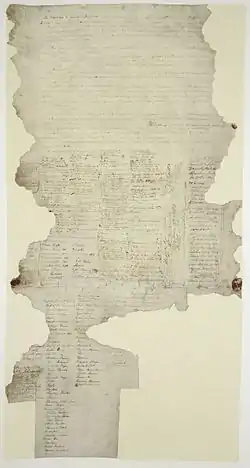
Selected article 8
Portal:New Zealand/Selected article/8
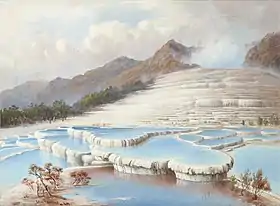
Similar to Pamukkale in Turkey, hot water containing large amounts of calcium bicarbonate precipitated calcium carbonate, leaving thick white layers of limestone and travertine cascading down the mountain slope, forming pools of water and terraces. The White terraces were the larger and more beautiful formation while the Pink terraces were where people went to bathe.
The terraces located on the edges of Lake Rotomahana near Rotorua were considered to be the eighth wonder of the natural world and were New Zealand's most famous tourist attraction ( they were attracting tourists from Europe in the early 1880s when New Zealand was still relatively inaccessible) until they were destroyed when Mount Tarawera, five kilometres to the north, erupted at 03:00 on June 10, 1886.
The volcano belched out hot mud, red hot boulders and immense clouds of black ash. The eruption caused approximately 153 deaths and buried the village of Te Wairoa. The lake, and several others nearby, were substantially altered in shape and area by the eruption. (Full article...)
Selected article 9
Portal:New Zealand/Selected article/9

Koru can also refer to bone carvings. Those generally take the shape of the uncurling fern plant. When bone is worn on the skin, it changes colour as oil is absorbed. The Māori took this to symbolise that the spirit of the person was inhabiting the pendant. When someone gives a pendant to someone else, it is the custom that they wear it for a time so that part of their spirit is given as well. (Full article...)
Selected article 10
Portal:New Zealand/Selected article/10
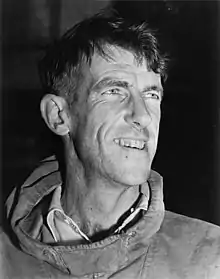
Hillary was created a Knight Commander of the Order of the British Empire (KBE) on 16 July 1953; a member of the Order of New Zealand (ONZ) in 1987; and a Knight of the Order of the Garter (KG) on 23 April 1995. He has been the only New Zealander to appear on a banknote during their lifetime. Various streets, schools, and organisations around New Zealand and abroad are named after him.
To mark the occasion of the 50th anniversary of the first successful ascent of Everest, the Nepalese Government conferred honorary citizenship upon Hillary at a special Golden Jubilee celebration in Kathmandu. He was the first foreign national to receive such an honour from the Nepalese. (Full article...)
Selected article 11
Portal:New Zealand/Selected article/11
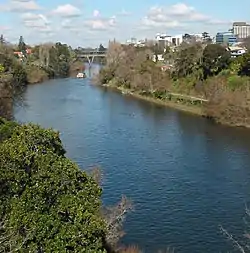
The name "Waikato" comes from Māori and translates as "flowing water". (Full article...)
Selected article 12
Portal:New Zealand/Selected article/12

Rutherford was born at Spring Grove (now Brightwater), near Nelson, New Zealand. His name was mistakenly spelt Earnest Rutherford when his birth was registered. He studied at Havelock and then Nelson College and won a scholarship to study at Canterbury College, University of New Zealand where he was president of the debating society among other things. In 1895, after gaining his BA, MA and BSc, and doing two years of research at the forefront of electrical technology, Rutherford travelled to England for postgraduate study at the Cavendish Laboratory, University of Cambridge (1895–1898), and he briefly held the world record for the distance over which electromagnetic waves could be detected. During the investigation of radioactivity he coined the terms alpha and beta to describe the two distinct types of radiation emitted by thorium and uranium. (Full article...)
Selected article 13
Portal:New Zealand/Selected article/13

The All Blacks compete annually with the Australian rugby team (the Wallabies), and the South African rugby team, (the Springboks), in the Tri-Nations Series, in which they also contest the Bledisloe Cup with Australia. The All Blacks have been Tri-Nations champions seven times in the tournament's eleven-year history, and twice completed a Grand Slam (in 1978 and in 2005), and currently hold the Bledisloe Cup. According to the official IRB World Rankings, the All Blacks are ranked second in the world behind current world champions South Africa. The All Blacks were also named the 2006 International Rugby Board (IRB) Team of the Year. Fourteen former All Blacks have been inducted into the International Rugby Hall of Fame, and one has been inducted into the IRB Hall of Fame.
The team first competed internationally in 1884 against Cumberland County, New South Wales, and played their first Test match in 1903, a victory against Australia. This was soon followed by a tour of the northern hemisphere in 1905, during which the team's only loss was to Wales in Cardiff. (Full article...)
Selected article 14
Portal:New Zealand/Selected article/14
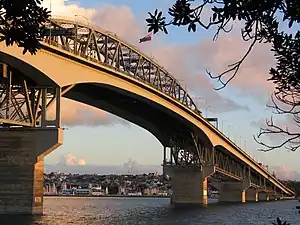
Selected article 15
Portal:New Zealand/Selected article/15
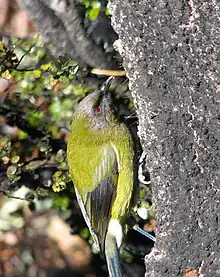
The bellbird is found throughout both the main islands of New Zealand apart from the north of the North Island. Its population and distribution had been seriously affected by the introduction of European-style farming, which has led to the removal of native forests (the natural habitat of the bellbird). Another important factor is the introduction of predatory species such as cats, weasels, stoats, ferrets, rats and food-robbing species like wasps. Predators either eat the birds or consume eggs, while food robbers compete with the bellbird for its natural food sources of nectar, honeydew and insects. The decline occurred around the same time as many other New Zealand species, but for unknown reasons was reversed and the species is still common across much of New Zealand (Bartle & Sagar 1987). (Full article...)
Selected article 16
Portal:New Zealand/Selected article/16

In 1915, Australian and New Zealand soldiers formed part of an Allied expedition that set out to capture the Gallipoli Peninsula, under a plan by Winston Churchill to open the way to the Black Sea for the Allied navies and capture Istanbul, capital of the Ottoman Empire. The ANZAC force landed at Gallipoli on 25 April, meeting fierce resistance from the Turkish Army commanded by Mustafa Kemal Atatürk. What had been planned as a bold strike to knock Turkey out of the war quickly became a stale-mate, and the campaign dragged on for eight months. At the end of 1915, the Allied forces were evacuated after both sides had suffered heavy casualties and endured great hardships. Over 8,000 Australian and 2,700 New Zealand soldiers died. News of the landing at Gallipoli made a profound impact on Australians and New Zealanders at home and 25 April quickly became the day on which they remembered the sacrifice of those who had died in war.
Though the Gallipoli campaign failed in its military objectives, the Australian and New Zealand troops' actions during the campaign bequeathed an intangible but powerful legacy. The "Anzac legend" became an important part of the national identity of both countries. (Full article...)
Selected article 17
Portal:New Zealand/Selected article/17
.jpg.webp)
Selected article 18
Portal:New Zealand/Selected article/18
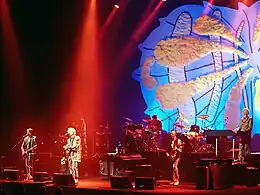
Selected article 19
Portal:New Zealand/Selected article/19
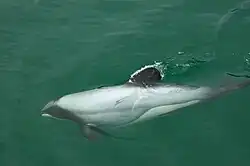
Hector's dolphins are endemic to the coastal regions of New Zealand. There are two known main populations, one on each side of the South Island. The two populations are believed to be largely cut off from one another by deep water at Cook Strait and at the south-west tip of the South Island.
According to the WWF, thirty years ago there were over 26,000 Hector's dolphins (and a subspecies, Maui's dolphin). Today, due to human activity, there is a struggling population of around 7,270 Hector's dolphins - and Maui's are the rarest marine dolphins in the world with around 110 left. (Full article...)
Selected article 20
Portal:New Zealand/Selected article/20

Selected article 21
Portal:New Zealand/Selected article/21
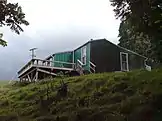
Selected article 22
Portal:New Zealand/Selected article/22

New Zealand's pre-human biodiversity exhibited high levels of endemism in its flora and fauna. The range of ancient fauna is not well-known but at least one species of non-flying terrestrial mammal existed in New Zealand around 19 Ma ago. Prior to 65 Ma ago, the fauna included dinosaurs, pterosaurs and marine reptiles.
For at least several Ma before the arrival of humans and their commensal species, the islands had no terrestrial mammals except for bats, the main component of the terrestrial fauna being insects and birds. Its flora is dominated by Gondwanan plants, comprising historically of forests, most famously the giant kauri, Agathis australis.
New Zealand has developed a national Biodiversity Action Plan to address conservation of considerable numbers of threatened flora and fauna within New Zealand. (Full article...)
Selected article 23
Portal:New Zealand/Selected article/23
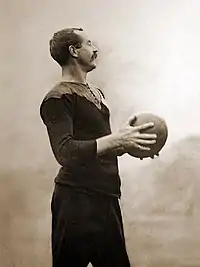
Gallaher played 26 representative matches for Auckland, including the first ever Ranfurly Shield defense, and 36 for the All Blacks, including 6 tests. Gallaher's All Black career spanned from 1903 to 1906, the highlight being the captaincy of the "Originals" tour in which he played 26 matches including 4 tests. Gallaher proved to be an outstanding leader and one of the deepest thinkers of the game in his era.
Gallaher fought in the Boer War serving as a corporal in the 6th and 10th New Zealand Contingents of Mounted Rifles. Although exempt from conscription due to his age, Gallaher also volunteered to fight in World War I, and apparently altered his date of birth to 31/10/76 or 31 October 1876 (see link to NZEF form below). He saw action at Ypres, and was killed during the Passchendaele offensive on 4 October 1917. He is buried at Nine Elms Cemetery, Poperinge, where his gravestone bears the silver fern. (Full article...)
Selected article 24
Portal:New Zealand/Selected article/24

Selected article 25
Portal:New Zealand/Selected article/25

As of 2005, the company had 253 stores throughout New Zealand and Australia along with more than 6 distribution centres in total. On November 24, 2005, The Warehouse announced that was selling its Australian operation for AU$98 million (NZ$99 million).
Colloquial names for the company's stores include "The Big Red Shed", "WareWhare" (pronounced wah-ray fah-reh, whare is Maori word for house), Warehu and "The Wuds". (Full article...)
Selected article 26
Portal:New Zealand/Selected article/26

Matariki has three hundred stars in total but you can see only seven in the night sky with the naked eye.
The first rising of the Pleiades and of Rigel (Puanga in Māori) occurs just prior to sunrise in late May or early June, and this indicates that the old year has ended and the new year has begun. The actual time for celebrating Matariki varies, depending on the iwi (tribe or clan). Some iwi celebrate it immediately. Others wait until the rising of the next full moon, or alternatively the dawn of the next new moon. It has become common practice for various private and public institutions to celebrate Matariki over the period of a week or month anywhere from early June to late July. Other iwi used the rising of Rigel in a similar way.
In traditional times, Matariki was a season to celebrate and to prepare the ground for the coming year. Offerings of the produce of the land were made to the gods, including Rongo, god of cultivated food. This time of the year was also a good time to instruct young people in the lore of the land and the forest. In addition, certain birds and fish were especially easy to harvest at this time. (Full article...)
Selected article 27
Portal:New Zealand/Selected article/27
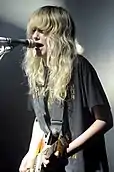
The Observer grouped Ladyhawke in with other singers gaining notice with their distinct fashion, 1980s references, and androgyny, including Lady Gaga, Little Boots, Lissy Trullie, and Elly Jackson's synth duo La Roux. (Full article...)
Selected article 28
Portal:New Zealand/Selected article/28
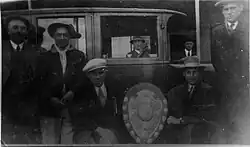
The Shield is currently held by Wellington, who won it from Auckland in Round 8 of the Round Robin in the 2008 Air New Zealand Cup.
Although the professional era of rugby has seen competitions such as the National Provincial Championship and its successor, the Air New Zealand Cup, and Super Rugby detracting from the pre-eminence of the Ranfurly Shield, many still regard it as the greatest prize in New Zealand rugby, thanks to its long history, the fact that every challenge is a sudden-death defence of the Shield, and that any team, no matter how lowly, has a chance to win. (Full article...)
Selected article 29
Portal:New Zealand/Selected article/29
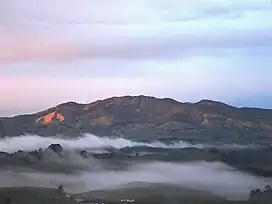
The project is engineered to remove all non-native pest mammals and predators and restore endangered native flora and fauna to Maungatautari. There is no intention to restrict all introduced birds, but efforts will be made to control non-native wasps.
It includes private land and a government-owned scenic reserve administered by Waipa District Council. It is a community project under the Maungatautari Ecological Island Trust. (Full article...)
Selected article 30
Portal:New Zealand/Selected article/30
In 2008, 138,000 players were registered with Netball New Zealand, the governing body for organised netball in the country. Organised competition ranges from interschool and local club netball to premier domestic competitions such as the ANZ Championship, with the pinnacle for netball players in New Zealand being selection for the national team. (Full article...)
Selected article 31
Portal:New Zealand/Selected article/31

Fernando Pereira, a photographer, drowned on the sinking ship. Two French agents were arrested by the New Zealand Police on passport fraud and immigration charges. They were charged with arson, conspiracy to commit arson, willful damage, and murder. As part of a plea bargain, they pleaded guilty to manslaughter and were sentenced to ten years, of which they served just over two.
The scandal resulted in the resignation of the French Defence Minister Charles Hernu, and the subject remained controversial. It was twenty years afterwards that the personal responsibility of French President François Mitterrand was admitted. (Full article...)
Selected article 32
Portal:New Zealand/Selected article/32
.jpg.webp)
Holyoake was the third longest-serving New Zealand prime minister (just under 12 years), surpassed only by Richard Seddon's 13 years and William Massey's close to 13 years; he was also the first to be born in the 20th century. He was known for his diplomatic style and "plummy" voice. He was also fondly (or mockingly) known as Kiwi Keith, a name given to him in childhood to distinguish him from an Australian child with the same name. (Full article...)
Selected article 33
Portal:New Zealand/Selected article/33

According to one tradition (Craig 1989:127), Kupe was a great chief of Hawaiki who arrived in New Zealand in 925 AD. He left his cousin Hoturapa to drown during a fishing expedition and kidnapped his wife, Kuramarotini, with whom he fled in her great canoe Matahourua. During their subsequent journeys, they overcame numerous monsters and sea demons, including the great octopus named as Te Wheke-a-Muturangi, and discovered New Zealand. Returning to Hawaiki, Kupe told of his adventures and convinced others to migrate with him. Traditions about Kupe appear among the peoples of the following areas: Northland, Ngāti Kahungunu, Tainui, Whanganui-Taranaki, Rangitāne, and the South Island.
A.H. Reed wrote that "When Kupe, the first discoverer of New Zealand,first came in sight of the land,his wife cried,'He ao! He ao!" (a cloud! a cloud!). Great Barrier Island was therefore named Aotea (white cloud), and the long mainland Aotearoa (long white cloud). When Kupe finally returned to his homeland his people asked him why he did not call the newly discovered country after his fatherland. He replied, 'I preferred the warm breast to the cold one, the new land to the old land long forsaken'." (Full article...)
Selected article 34
Portal:New Zealand/Selected article/34
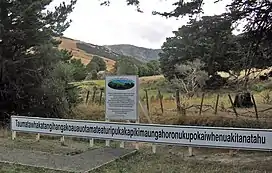
It is featured in a Mountain Dew jingle and it is also in the 1979 single "Lone Ranger" by British band Quantum Jump. It is the subject of a 1960 song by the New Zealand balladeer Peter Cape[1], as well as Hardcore DJ's Darkraver and DJ Vince in the song 'Thunderground'.
The name of this hill translates roughly as
| “ | The summit where Tamatea, the man with the big knees, the climber of mountains, the land-swallower who travelled about, played his nose flute to his loved one. | ” |
At 85 letters, it has been listed in the Guinness World Records as one of the longest place names in the world. (Full article...)
Selected article 35
Portal:New Zealand/Selected article/35
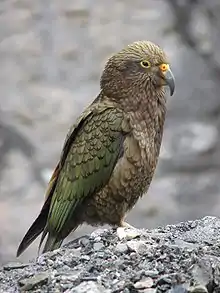
Kea are legendary for their intelligence and curiosity, both vital to their survival in a harsh mountain environment. Kea can solve logical puzzles, such as pushing and pulling things in a certain order to get to food, and will work together to achieve a certain objective.
Most people only encounter wild Kea at South Island ski areas. Kea are attracted by the prospect of food scraps. Often described as "cheeky", Keas' curiosity leads them to peck and carry away unguarded items of clothing, or to pry apart rubber parts of cars - to the entertainment and annoyance of human observers. In 2009, a Scottish tourist reported that a Kea stole his passport while he was visiting the Fiordland National Park. (Full article...)
Selected article 36
Portal:New Zealand/Selected article/36

Walker is best known for being the first human being to run the mile in under 3:50 minutes, posting a time of 3:49.4, breaking the existing world record by over 1.5 seconds. This was a full 10 seconds faster than Roger Bannister's historic sub-Four-Minute Mile of 3:59.4 that was run twenty-one years previous. He was named Athlete of the Year by Track and Field News the same year.
The following year, 1976, Walker won the Olympic Games 1500 metres in Montreal, with a time of 3:39.17. Walker also broke the world record for the 2000 metres, running 4:51.4 minutes in Oslo, Norway, on 30 June 1976. He smashed the existing ten-year-old record held by Michel Jazy by nearly five seconds, Walker regarded this run as the best he ever ran. Steve Cram would not better Walker's record by running 4:51.4 at Budapest, Hungary until 4 August 1985. Indoors, Walker broke the 1500 metre world record with a time of 3:37.4 in 1979. (Full article...)
Selected article 37
Portal:New Zealand/Selected article/37
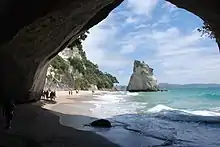
The Māori name Te Whanganui-A-Hei (the Great Bay of Hei) refers to Hei, a tohunga from the Te Arawa waka. According to tradition, Hei chose the area around Mercury Bay as home for his tribe, proclaiming ownership by calling Motueka Island "Te Kuraetanga-o-taku-Ihu" (the outward curve of my nose.)
Cathedral Cove is named after the cave located there linking Mare’s Leg Cove to Cathedral Cove. Gemstone Bay and Stingray Bay are also located within the reserve. The area is very popular with tourists, and receives around 150,000 visitors a year. The cave and beach was used as the tunnel through which the Pevensie children first re-enter Narnia in the movie version of The Chronicles of Narnia: Prince Caspian. (Full article...)
Selected article 38
Portal:New Zealand/Selected article/38

The tree grows up to 20 metres (66 ft) in height, with a dome-like spreading form. Its natural range is the coastal regions of the North Island of New Zealand, north of a line stretching from New Plymouth (39° S) to Gisborne (38° S). It also grows on the shores of lakes in the Rotorua area. A giant Pōhutukawa at Te Araroa on the East Coast is reputed to be the largest in the country, with a height of 20 metres and a spread of 38 metres (125 ft). The tree is renowned as a cliff-dweller, able to maintain a hold in precarious, near-vertical situations. Some specimens have matted, fibrous aerial roots. Like its Hawaiian relative the ʻōhiʻa lehua (M. polymorpha), the Pōhutukawa has shown itself to be efficient in the colonisation of lava plains – notably on Rangitoto, a volcanic island in the Hauraki Gulf.
The Pōhutukawa flowers from November to January with a peak in mid to late December (the southern hemisphere summer), with brilliant crimson flowers covering the tree, hence the nickname New Zealand Christmas Tree. (Full article...)
Selected article 39
Portal:New Zealand/Selected article/39
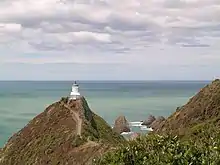
The Catlins, a rugged, sparsely populated area, features a scenic coastal landscape and dense temperate rainforest, both of which harbour many endangered species of birds. Its exposed location leads to its frequently wild weather and heavy ocean swells, which are an attraction to big-wave surfers.
Ecotourism has become of growing importance in the Catlins economy, which otherwise relies heavily on dairy farming and fishing. The region's early whaling and forestry industries have long since died away, along with the coastal shipping that led to several tragic shipwrecks. Only some 1,200 people now live in the area, many of them in the settlement of Owaka. (Full article...)
Selected article 40
Portal:New Zealand/Selected article/40
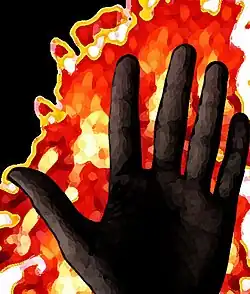
Māui emerged from the sea and found his four brothers, Māui-taha, Māui-roto, Māui-pae, and Māui-waho. Māui's brothers at first are wary of the new-comer but, after he performs several feats such as transforming himself into different kinds of birds, they acknowledge his power and admire him.
With the help of his brothers, Māui netted the Sun and beat him severely with a jaw-bone club until the Sun promised to go slower in future, because the days were getting too short for people to get their work done.
Later, Māui took his brothers fishing, this time using the jaw-bone as a fish-hook. Māui, using blood from his nose for bait, hauled a great fish up from the depths, which became the North Island of New Zealand, or Te Ika-a-Māui (The Fish of Māui).
When the people need to recover the lost secret of fire, it is up to Māui to face Mahuika the Fire-goddess. He succeeds through trickery, infuriating the goddess, and he barely escapes with his life. (Full article...)
Selected article 41
Portal:New Zealand/Selected article/41
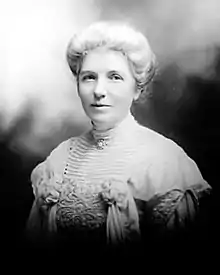
Sheppard's interest in women's suffrage went beyond practical considerations regarding temperance: her views were made well known, summed up with her statement:
| “ | All that separates, whether of race, class, creed, or sex, is inhuman, and must be overcome | ” |
Sheppard was a powerful speaker and a skilled organiser, and quickly built support for her cause. (Full article...)
Selected article 42
Portal:New Zealand/Selected article/42

Traditionally, Maori used the Milford Track for gathering and transporting valuable greenstone. Sutherland and Mackay were the first European explorers to see Mackay Falls and Sutherland Falls, in 1880.
With Milford Sound never exploited by industrial or agricultural interests, most visitors and investors from early on decided that tourism was to be the main draw to the sound, and the Milford Track was established to a large degree to provide a tourism function for guided treks.
The track spans a distance of 53.5 km starting at the head of Lake Te Anau and finishing at Milford Sound at Sandfly Point. It traverses rainforests, wetlands, and dramatic alpine passes.
As a popular route, it is well maintained by the Department of Conservation and is one of the nine Great Walks. (Full article...)
Selected article 43
Portal:New Zealand/Selected article/43
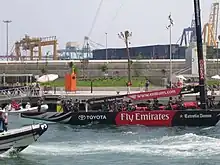
In 1987, the nation was captivated by KZ7 "Plastic Fantastic", racing well in Fremantle, but finally beaten by the American Dennis Conner. The following year, Michael Fay built and raced a gigantic monohull called KZ1 (or the Big Boat) but was outclassed by Conner's catamaran.
In 1995 TNZ stunned the world, beating Team Dennis Conner 5-0 off the coast of San Diego, after winning the Louis Vuitton Cup. The 1995 yacht NZL 32 was nicknamed Black Magic, ably skippered by Russell Coutts, and the legendary Sir Peter Blake. Coining the famous phrase by sailing commentator Peter Montgomery, "The America's Cup is now New Zealand's cup!".
The 2000 challenge was held on Auckland's Hauraki Gulf. On crossing the finish line in the final race, TNZ (NZL 60) beat Italy's Prada Challenge (Luna Rossa) 5-0. Team New Zealand's eight-year reign ended after they were defeated 5-0 by Swiss-based challenger Alinghi in 2003. (Full article...)
Selected article 44
Portal:New Zealand/Selected article/44

The flight was specifically designed and marketed as a unique sight-seeing experience, carrying an experienced Antarctic guide who would point out scenic features and landmarks using the aircraft public address system.
On November 28, 1979, at 12:49pm NZDT, flight TE901 collided with Mount Erebus, Antarctica, killing all 237 passengers and 20 crew members. The flight that day was being operated by the DC-10 registered ZK-NZP, which was just under 5 years old. The aircraft altitude at the time of the collision was just 1465 feet (445 metres). (Full article...)
Selected article 45
Portal:New Zealand/Selected article/45
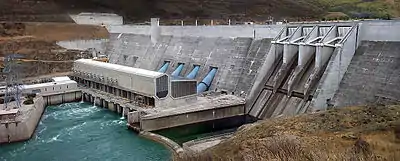
The core 'Think Big' projects included the construction of the Mobil synthetic-petrol plant at Motunui, the complementary expansion of the oil-refinery at Marsden Point near Whangarei, and the building of a stand-alone plant at Waitara to produce methanol for export. Motunui converted natural gas from the off-shore Maui field to methanol, which it then converted to petrol on-site. Declining oil prices rendered this process uneconomic and New Zealand abandoned the manufacture of synthetic petrol. The construction of the Clyde Dam on the Clutha River formed part of a scheme to generate electricity for smelting aluminium.
The New Zealand economy probably benefited from economic activity during the construction period, but the basic justification for the projects, a permanently higher oil-price, did not happen. Oil prices subsequently dropped in real terms. (Full article...)
Selected article 46
Portal:New Zealand/Selected article/46
.jpg.webp)
Before taking leadership of the Labour Party, Clark had held portfolios in Health, Housing, Conservation, Labour, and served as Deputy Prime Minister. She also had ministerial responsibility for the New Zealand Security Intelligence Service and for Ministerial Services. Her particular interests included social policy and international affairs.
Before resigning from Parliament in April 2009, Clark was Labour's foreign affairs spokeswoman and MP for the Mount Albert electorate which she had held since 1981. Forbes magazine ranked her the 20th most powerful woman in the world in 2006. (Full article...)
Selected article 47
Portal:New Zealand/Selected article/47
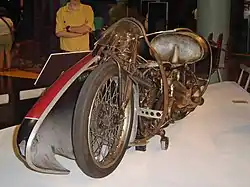
Working from his home in Invercargill, he worked for 20 years to highly modify the 1920 Indian motorcycle which he had bought in 1920. Munro set his first New Zealand speed record in 1938 and later set seven more. He travelled to compete at the Bonneville Salt Flats, attempting to set world speed records. During his ten visits to the salt flats, he set three speed records, one of which still stands today. His efforts, and success, are the basis of the motion picture The World's Fastest Indian (2005), starring Anthony Hopkins, and an earlier 1971 short documentary film Burt Munro: Offerings to the God of Speed (Full article...)
Selected article 48
Portal:New Zealand/Selected article/48

Designed by George Troup, the station is the fourth building to have served as Dunedin's railway station. It earned its architect the nickname of "Gingerbread George".
In Flemish style, it is constructed from local dark basalt rock capped with lighter Oamaru stone, giving it the distinctive light and dark pattern common to many of the more stately buildings of Dunedin and Christchurch. The booking hall features a mosaic floor of almost 750,000 tiles of Royal Doulton porcelain. Its main platform is the country's longest, being one kilometre in length. It was opened in 1906 by Prime Minister Joseph Ward. A thorough refurbishment of the exterior took place in the late 1990s, accompanied by the landscaping of the gardens outside the entrance, in Anzac Square.
With the decrease in passenger rail traffic, the station now serves more functions that the one for which it was originally designed. It is still the city's railway station, catering for the Otago Excursion Train Trust's Taieri Gorge Railway tourist train. Much of its ground floor is now used as a restaurant, and the upper floor is home to both the New Zealand Sports Hall of Fame and the Otago Art Society. (Full article...)
Selected article 49
Portal:New Zealand/Selected article/49

Some sources say the recipe originated in New Zealand, while others claim it was invented in Australia. However, like the Anzac biscuit, the earliest known books containing the recipe were published in New Zealand.
Professor Helen Leach, a culinary anthropologist at Otago University in New Zealand found a pavlova recipe in a 1933 Rangiora Mothers' Union cookery book. Professor Leach also has an even earlier copy of the pavlova recipe from a 1929 rural New Zealand magazine.
Keith Money, a biographer of Anna Pavlova, wrote that a chef at a hotel in Wellington, New Zealand, created the dish when Pavlova visited there in 1926 on her world tour.
The claim that it was an Australian invention states that the pavlova is based on a cake baked by Bert Sachse at the Esplanade Hotel in Perth on 3 October 1935. Sachse's descendants believe he may have come up with the recipe earlier than that, since Anna Pavlova visited Australia in 1926 and 1929 and died in 1931. (Full article...)
Selected article 50
Portal:New Zealand/Selected article/50
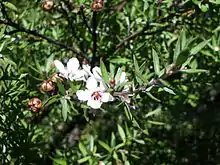
Manuka (from Māori mānuka) is the name used in New Zealand. It is also commonly called the tea tree. This name arose because Captain Cook used the leaves to make a tea drink. (Full article...)
Selected article 51
Portal:New Zealand/Selected article/51

Selected article 52
Portal:New Zealand/Selected article/52
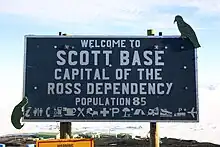
Scott Base participates in ANDRILL, investigating Antarctica's impact on global ocean currents and climate over the past 65 million years, by retrieving ice and rock samples representing ancient geologic time. Scott Base is administered by Antarctica New Zealand, as part of their efforts to "support scientific research, conserve the intrinsic values of Antarctica and the Southern Ocean, and raise public awareness of the international significance of the continent."
New Zealand also co-operates with the US Operation Deep Freeze which uses Christchurch International Airport as a staging point for McMurdo Station. (Full article...)
Selected article 53
Portal:New Zealand/Selected article/53 George Arthur Emilius Ross (some sources say Aemilius, Æmilius, or Emileus; 1829 – 23 November 1876) was a New Zealand farmer and provincial politician. A cultured and well-educated man, he suffered a breakdown while at Oxford University and relocated to Christchurch for health reasons before he finished his degree. After a short period as a cadet to learn the basics of sheep farming, he became a major land owner. He was an elected member of the Canterbury Provincial Council (1858–1861; 1862–1865) for the rural Rakaia electorate and was on the Canterbury Provincial Executive Council on a number of occasions (1859; 1863–1867) including nearly two years as provincial treasurer. Well-liked as an individual, he was chaotic as a businessman and went bankrupt after a harsh winter in 1867 that caused great loss of stock. He suffered a mental breakdown and disappeared from public life thereafter, with his young wife, Sibella, sustaining the family by running a school that her parents had financed for them. Ross died young aged 48 and his wife outlived him by five decades, bringing up a family of eight children by herself. The West Coast town of Ross was named after him during his lifetime. (Full article...)
Selected article 54
Portal:New Zealand/Selected article/54
A major earthquake occurred in Christchurch on Tuesday 22 February 2011 at 12:51 p.m. local time (23:51 UTC, 21 February). The Mw6.2 (ML6.3) earthquake struck the Canterbury region in the South Island, centred 6.7 kilometres (4.2 mi) south-east of the central business district. It caused widespread damage across Christchurch, killing 185 people, in New Zealand's fifth-deadliest disaster.
Christchurch's central city and eastern suburbs were badly affected, with damage to buildings and infrastructure already weakened by the magnitude 7.1 Canterbury earthquake of 4 September 2010 and its aftershocks. Significant liquefaction affected the eastern suburbs, producing around 400,000 tonnes of silt. The earthquake was felt across the South Island and parts of the lower and central North Island. While the initial quake only lasted for approximately 10 seconds, the damage was severe because of the location and shallowness of the earthquake's focus in relation to Christchurch as well as previous quake damage. Subsequent population loss saw the Christchurch main urban area fall behind the Wellington equivalent, to decrease from second- to third-most populous area in New Zealand. Adjusted for inflation, the earthquake caused over NZD$77 billion in damage, making it New Zealand’s costliest natural disaster and the 21st-most-expensive disaster in history. (Full article...)
Selected article 55
Portal:New Zealand/Selected article/55
Ella Marija Lani Yelich-O'Connor (born 7 November 1996), known professionally as Lorde (/lɔːrd/ LORD), is a New Zealand singer and songwriter. Taking inspiration from aristocracy for her stage name, she is known for her unconventional musical styles and introspective songwriting.
Lorde expressed interest in performing at local venues in her early teens. She signed with Universal Music Group (UMG) in 2009 and collaborated with producer Joel Little in 2011 to start recording music. Their first effort, an extended play (EP) titled The Love Club, was self-released in 2012 for free download on SoundCloud before UMG's commercial release in 2013. The EP's international chart-topping single "Royals" helped raise Lorde to prominence. Her debut studio album Pure Heroine was released that same year to critical and commercial success. The following year, Lorde curated the soundtrack for the 2014 film The Hunger Games: Mockingjay – Part 1 and recorded several tracks, including the single "Yellow Flicker Beat". (Full article...)
Selected article 56
Selected article 57
Selected article 58
Selected article 59
Selected article 60
The current week is :
Week 42.
Use the template {{Selected article}} to add pages.
For previous selected articles, pictures and DYK?, see Portal:New Zealand/Previously_featured.

_(52119260286)_(cropped2).jpg.webp)